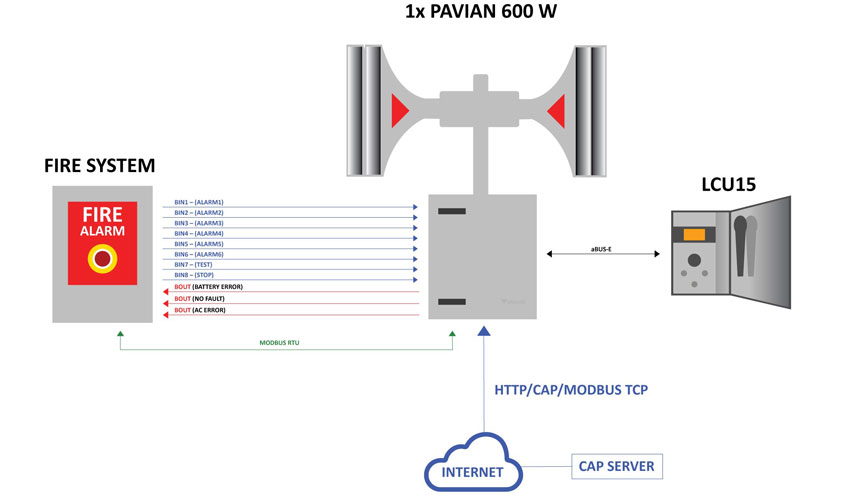
Excelent CONNECTIVITY – an underestimated feature of the Pavian electronic siren
Listen to article:
The latest trends highlight a focus on complexity when building security infrastructure. From schools and campuses to civil buildings, hospitals, shopping malls, offices, factories, and power plants, a myriad of safety devices is now standard, all requiring seamless cooperation to ensure timely and effective communication during emergencies. These safety components can be broadly categorized into three groups based on their function:
- Detection – encompassing surveillance and monitoring devices, fire detectors, metal detectors, and access controls.
- Activators – including panic buttons, door locks, mobile apps, control centers or operator panels.
- Warning – consisting of fire alarms, PA systems, electronic sirens, and mobile notifications.
Effective communication across all three stages is essential to identifying potential threats early and disseminating warnings to all affected areas. Sirens or high power speaker arrays are one of the crucial part of the complex warning systems mainly due to following reasons:
- Audibility – They easily target masses and immediately capture everyone’s attention, unlike TV, radio, or mobile notifications.
- Instruction Dissemination – They not only spread sound alarms but also provide instructions.
- Outdoor Warning Capability – They serve as the only audible tool for outdoor warnings.
However, to effectively alert people during emergencies,these sirens rely on inputs from detectors and activators, therefore good connectivity is the key element when building safety infrastructure. Here are three examples illustrating how our electronic siren, the Pavian, can be seamlessly integrated into your safety plan:
Siren direct connection to fire alarm
The simplest method to integrate our siren into existing fire safety infrastructure is by directly linking it to the fire alarm. This communication can be facilitated through various means such as binary inputs and outputs, analog inputs, serial lines like TLG-02 (our internal public protocol), Modbus protocols, HTTP, or CAP. This bidirectional communication allows not only activation but also the control of the siren status. Additionally, equipping the siren with a local control unit enables separate activation or utilization for different emergency scenarios.

Sensor-Controlled Activation
In scenarios where warning infrastructure is based on monitoring specific parameters (such as water levels for dams, radiation for nuclear power plants, seismic activity for earthquakes, or weather conditions), the siren may be directly connected to the sensors or an intermediate device like a monitoring station (EMA) can be added between sensors and sirens. The EMA collects and evaluates data from sensors and, upon reaching critical values, can inform warning control centers, notify people through mobile devices or autonomously activate the siren. The station communicates through various wireless and wired channels, ensuring comprehensive coverage. To learn more about our monitoring stations, read our blog: https://www.electronic-sirens.com/monitoring-stations-the-key-to-reliable-warning-systems/
When your warning infrastruce is based on some kind of monitoring (water levels for dams, radiation for nuclear power plants or seismic activity for earthquakes, weather conditions or stability of building structures), there may be the intermediate device added between sensor or siren, e.g. monitoring station(EMA) and control panels. EMA serves for collection and evaluation of data from sensors. When the measurements reach critical values, EMA is capable to activate the siren itself, inform warning control centres, or mobile devices. The station communicates with all standard wireless and wired communication channels – through GSM and mobile operator networks, WiFi, Ethernet, Modbus protocol, RS232, RS485, and analogue radio. Enriching the whole system by operational control panel gives the opportunity to activate also other safety tools.
Integration with VEKTRA®
The most sophisticated solution designed by Telegrafia is ruled and coordinated by our software app VEKTRA® – server-client based system comprising multiple modules, with Vektra ® Warning and Vektra® SCADA being essential for coordinating multiple safety devices. How does it work in practice? Vektra SCADA allows operators to supervise monitoring devices and manage system elements. When the monitored values exceed the thresholds, the system automatically controls technological devices such as access control – opening/closing windows or doors, activating/deactivating fire alarms, switching on/off ventilation or air conditioning, controlling lighting and visual signaling, etc., and activates warning processes using Vektra Warning. This application enables rapid and efficient control of sirens and offers features like live voice broadcasting, replying pre-recorded messages or using Text-To-Speech. Morereover, Vektra® Notification can be implemented to notify rescue teams or emergency units via SMS, voice or email. Vektra apps are connected to sirens and other safety and monitoring devices through following protocols: http, Modbus TCP , OPC-UA or CAP. Combining Ethernet communication with GSM or radio backup ensures that the system will continue to function even in the event of dramatic events, power failure, etc. For a real-life demonstration, explore our project for the OMV refinery in Romania, where all four modules of the VEKTRA software were employed to coordinate security structures: https://www.electronic-sirens.com/telegrafia-at-omv-petrom-refinery-summary-of-the-control-centre-modernization/ or about Flood warning system in Yemen: https://www.electronic-sirens.com/success-story-flash-flood-warning-system-in-yemen/
These 3 ways of siren integration into huge and complex security systems demonstrate the versatility and effectiveness of the Pavian electronic siren in diverse safety scenarios, ensuring robust communication and timely responses during emergencies. Explore our website for further insights into our pioneering solutions and transformative projects.

The article was written by
Dominika Pavlíková
Dominika is an international business manager responsible for the US and Canadian markets. She is a woman full of energy that she needs to invest into meaningful things. That’s how she fell in love with the mass notification industry. Dominika is also passionate about learning and continuous development. She loves people, books, art, history and new challenges, which makes her feel more alive.
